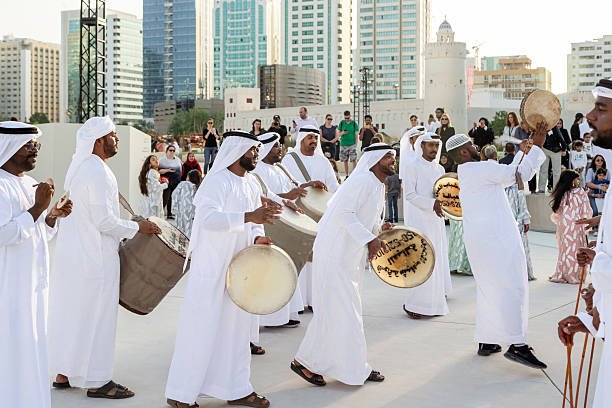The United Arab Emirates’ cultural heritage shines vibrantly through its traditional dances, which have been passed down through generations. More than artistic expressions, these dances preserve the nation’s history, values, and communal spirit. From the rhythmic Al Ayala to the warrior-like Al Harbiya, each performance reflects the UAE’s deep connection to its desert landscapes, maritime past, and Bedouin traditions.

Historically performed at weddings, festivals, and tribal gatherings, these dances embody stories of courage, unity, and celebration. Below are the most iconic Emirati dances and their significance.
1. Al-Ayala (العیالة)
UNESCO Status: Recognized as Intangible Cultural Heritage (2014).
Performance:
- Men form opposing lines, swaying to drumbeats and poetic chants.
- Bamboo sticks (asaya) are rhythmically clicked, symbolizing Bedouin unity and bravery.
Occasions: Weddings, National Day, cultural festivals.
2. Al-Razfa (الرزفة)
The Warrior’s Dance: Celebrates strength and heritage.
Performance:
- Two rows of men clap and chant nawati poetry.
- Some wield rifles or swords, evoking historical battles.
- Drums mimic galloping horses.
Modern Use: National Day parades and heritage events.
3. Al-Habban (الھبان)
Pearl Diving Legacy: Honors the UAE’s maritime history.
Performance:
- Dancers in kanduras mimic rowing motions in circles.
- Accompanied by fijiri sea shanties.
4. Al-Wanaah (الوانة)
Women’s Elegance: Performed at private gatherings.
Performance:
- Women circle gracefully, balancing mabkhara (incense burners) on their heads.
- Colorful jalabiyas swirl to soft drumming.
5. Al-Liwa (اللیوا)
African Influence: Rooted in historic trade with Swahili cultures.
Performance:
- Men swing a long, vibrant cloth (liwa) to drumbeats.
- Celebrated during Eid and harvest festivals.
6. Al-Khamiri (الخمیري)
Northern Emirates’ Energy:
Performance:
- High-energy jumps and footwork in hizan (beaded belts).
- Featured at sporting events and local fairs.
Traditional Music & Instruments
Dances are brought to life by:
- Tabl (drums) – Sets the rhythm for Al Ayala.
- Rebab (string instrument) – Adds melodic depth.
- Tambourines – Accents clapping in Al Razfa.
Modern Cultural Significance
Despite urbanization, these dances thrive as symbols of national identity:
- Taught in schools to preserve heritage.
- Featured at global events like Expo 2020 Dubai.
- Tourist attractions at Al Shindagha (Dubai) and Qasr Al Hosn (Abu Dhabi).
Where to Experience Emirati Dances
- Dubai Heritage Village – Daily cultural shows.
- Sharjah Heritage Days – Annual immersive festivals.
- Al Dhafra Festival – Camel races + traditional performances.
- December 2nd (UAE National Day) – Grand public celebrations.
